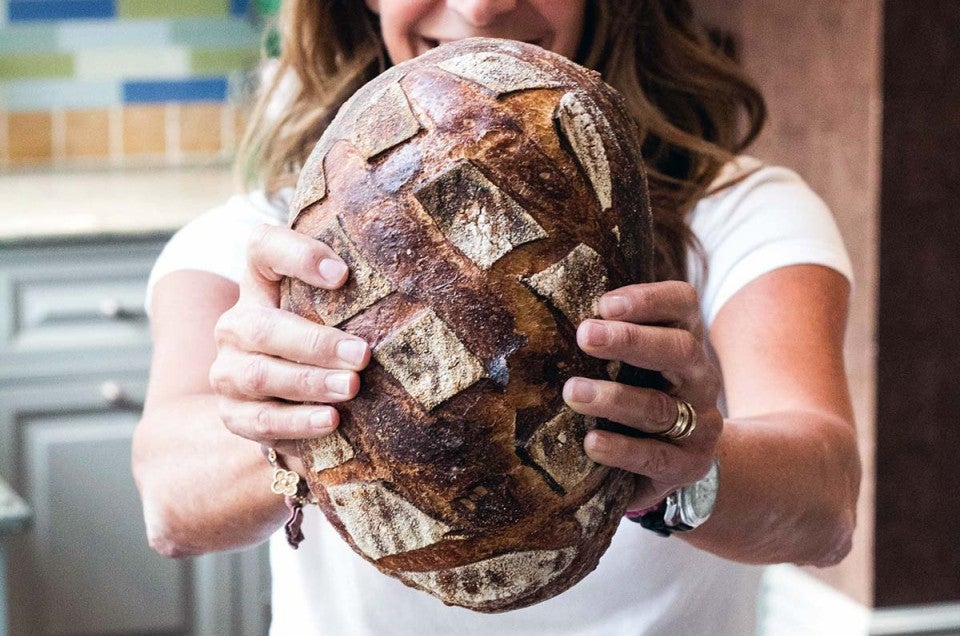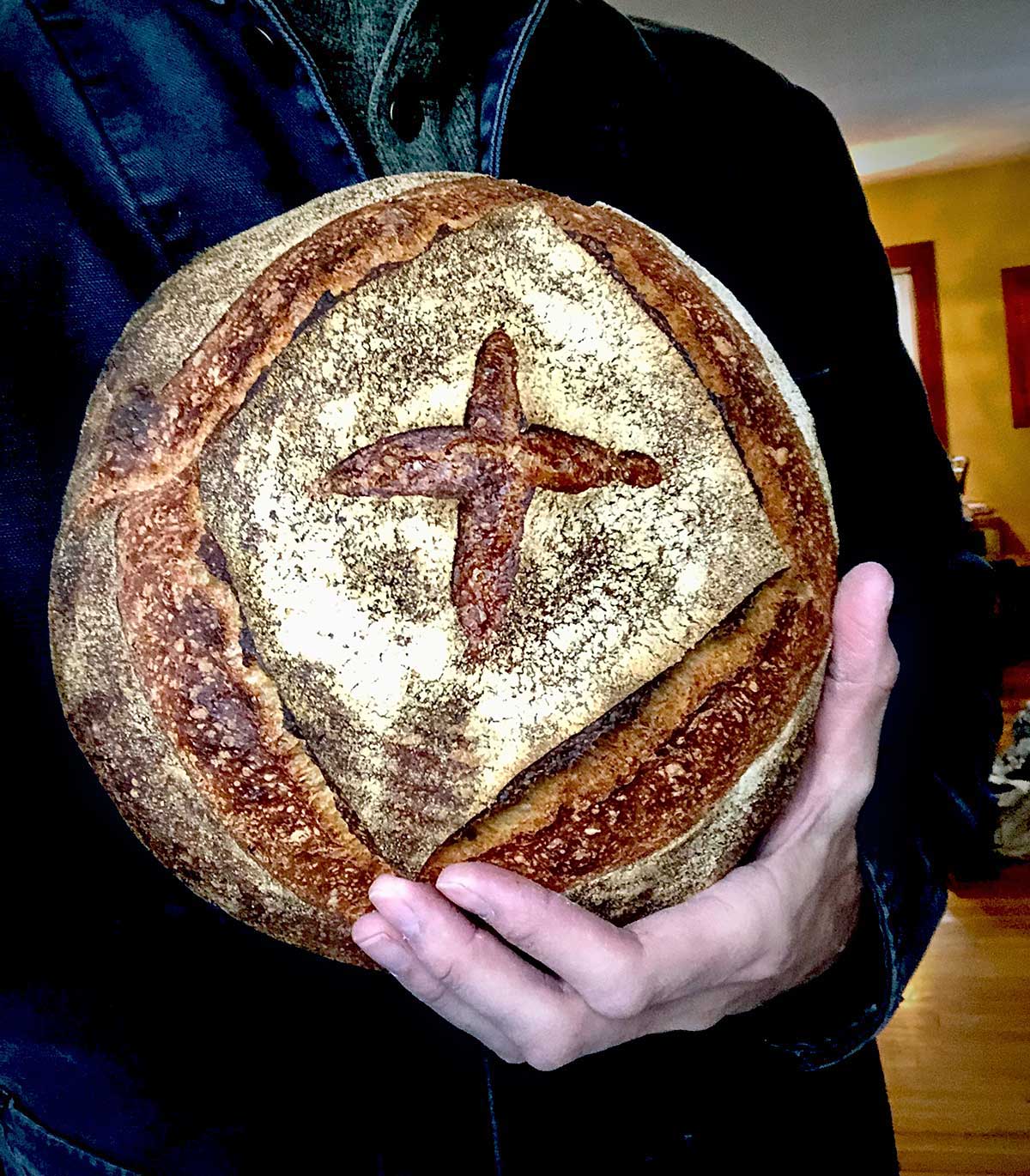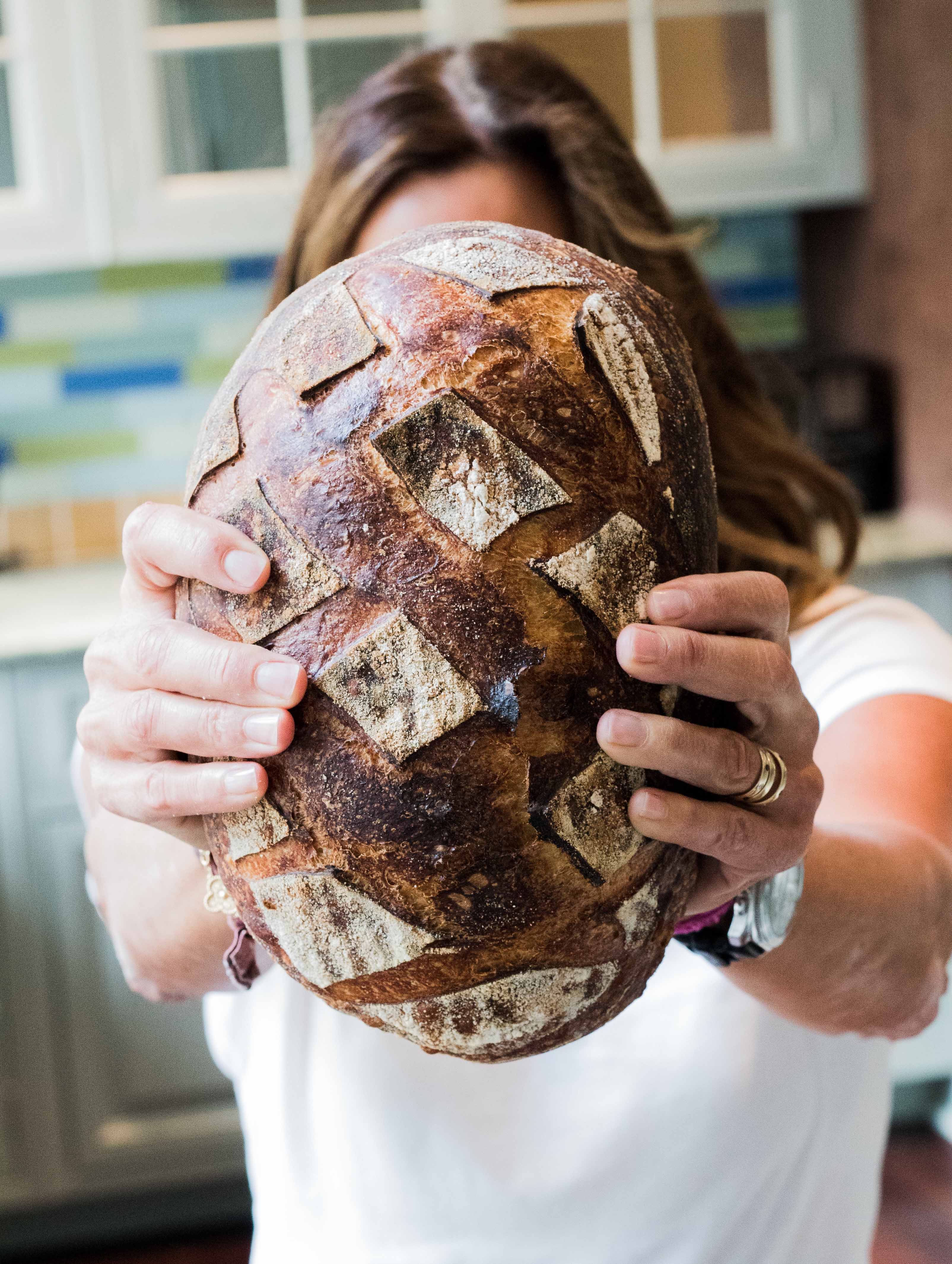


Bakers are friendly people. So friendly, in fact, that they ping my phone at all hours. Sometimes it’s a question (Hey! Where can I get those proofing baskets!?) or a picture of a great bake (Check this out!!! Jealous?) or a request for a recipe (Send me that Rye Pretzel pls). The conversation is open — you don’t need an intro — just let the random texts fly!
Recently, one of these exchanges changed the way that I make bread at home.
Maura: I’m not using preferments. I just use starter from the fridge ...
Me: No preferment??!
Maura: Nope
Me: How much bulk fermentation?
Maura: 12 hours ... it works ...
Me: ???? Send me a picture
Maura Brickman, a serious home baker in Connecticut, followed up her text with a picture of a large crusty loaf with gorgeous color. It was bakery quality by anyone’s standard — and she made it with "unrefreshed starter," straight from the refrigerator.

As a baker, convention has been my path to reliable results. I trust what I have done before — I know how to produce reliable results.
Maura doesn't care about convention. Free of “should” and “ought to,” she bends her breadmaking process to fit her busy schedule. She doesn’t take any guff from her starter or loaves — she's the boss of her bread.
After some thought about her method and convinced that there must be a flaw, I decided to give the Boss’ method a shot.
Before I outline her process, let me quickly clarify standard procedure: the way things normally go.
Sourdough bread traditionally begins with a preferment — a dough set for 12 to 18 hours to develop flavor — followed by mixing and bulk fermentation. After bulk, we divide, shape, proof (either at room temperature or chilled until the next day), and bake.
Maura alters this process to fit her day. Remember: She’s the boss! Rather than setting a preferment, she skips directly to the final mix, using a small amount of starter that she feeds once a week and keeps in the refrigerator to leaven her sourdough bread. After the mix, her dough rises for approximately 12 hours before the divide and shape.

If you've read the piece that I wrote about preferments and flavor, you’ll know that I think they're the difference between run of the mill and a loaf you’ll remember. In this method, which skips the preferment, flavor comes from the long bulk fermentation. We’ve got flavor covered — just in an unorthodox way.
But why not just go with the normal process? Here’s the answer.
Have you ever been a bread hostage? Did you ever feel like, “I’d love to make bread but I don’t have a half day to do so.” Or, “I’d love to attend your wedding, but I might be making bread that day.” At my house, there's quite a bit of coming and going. While I enjoy the opportunity to slow down and make beautiful things, there are also days where I just need to put great sourdough bread on the table.
As a professional baker, the needy schedule of bread and pastry can rule my day. But when I’m on my own time, it can be a challenge to fit everything in. Does this ring a bell?
Maura’s system offers several points of relief. First, it allows me to limit my dough interactions to the beginning or end of the day (no more “take your dough to work” scenarios).
Second, I don’t have to plan too far ahead if I want to mix up a dough (remember, no preferment, just grab some starter and go).
And last, there's no discard. I can thumb past all the delicious recipes for discarded starter, which (although amazing!) I may or may not have time to try.
Here’s Maura's process.

Maura usually starts after dinner, around 8 p.m. Like many serious bread bakers, she measures her ingredients exclusively by weight, so I’m going to do the same in this article. She also tracks the temperature of her ingredients. In this case, all dry ingredients should be room temperature, 70 to 72°F.
In a 6-quart container, combine the following:
900g King Arthur Unbleached Bread Flour
100g King Arthur Whole Wheat or Golden Whole Whole Wheat
800g tepid water (75°F to 80°F )
20g salt
40g sourdough starter, unfed/discard
Use starter straight from the fridge, though it’s best if fed within the past week.
Mix the ingredients by hand until the dough forms a shaggy mass and the flour is hydrated.
Set a 15-minute timer and leave the dough in the container at room temperature with the lid on.

At 15 minutes, return to the container and fold by pulling the sides of the dough up with a wet hand, then pressing to the middle to seal. Repeat this on all four sides, then set the timer again for 15 minutes.
Wait and fold the dough two more times. As you perform the folds you’ll notice that the dough smooths out, gaining strength and becoming elastic (more like a rubber band).
Leave the dough covered tightly at room temperature (approximately 72°F) overnight (about 12 hours). If using a mixing bowl, place the bowl in a plastic bag. If using a 6-quart container, just put the lid on — the main point here is that the dough should be well-covered to keep the exposed surface moist.

At 8 a.m. the next day (don’t be too uptight here — it could be 7 a.m. or 9 a.m.), divide the dough into two pieces. Gently form them into rounds, seam-side down, and rest for 10 minutes, covered.
Generously and evenly dust two lined bannetons with whole wheat flour.

Shape the loaves into boules or batards. If your dough doubled on the overnight rise (the marked 6-quart container will help with judging this), put the loaves straight into the refrigerator. If it's risen by just 50%, leave the loaves out for a bit (30 to 60 minutes) and then put them in the fridge. Note that the loaves should be covered with a shower cap or plastic bag.
Maura’s baking schedule (which is essentially a daily habit — no wonder she’s so good at it!) aligns well with her generous nature. Some days she bakes in the morning and distributes loaves to friends or neighbors. When her kids are home from college, she adjusts; they can easily polish off a loaf with dinner.
To bake, preheat two Dutch ovens — approximately 4-quart size — in a 500°F oven for 45 minutes. (Make sure your Dutch ovens are tough enough to be preheated empty; not all are. Check the manufacturer's literature.)
Invert the risen loaves onto a sheet of parchment, score with a lame, and carefully place the dough in the preheated Dutch ovens. Replace the lids and return to the oven.

Reduce the oven temperature to 450°F and bake for 20 minutes with the lids in place.
After 20 minutes, remove the lids and bake for another 20 to 25 minutes, or until the loaves have deep color.
After a few months of making Maura’s bread and receiving lots and lots of feedback from my family (often with a mouth full of bread), it’s become our daily loaf — the one that sits on our breadboard next to the butter. I’ve shared the process (via text) far and wide and have watched many people take on the role of Bread Boss.
As I’m an endless tinkerer and bread obsessed, I've adapted the recipe slightly. Here are some notes:
I use the same amount of flour (1,000g) but divide it differently. I use 750g of King Arthur Unbleached All-Purpose Flour. It’s strong enough for a good artisan loaf and it’s my Flour Power for the non-whole grain portion of just about everything in the house.
For the remaining 250g, I use a mixture of whatever flour I have on hand: whole wheat, golden whole wheat, whole rye, whole spelt, or even a little bit of buckwheat. I use a different blend of whole grains almost every time. My loaf is a little darker than Maura’s, but I love the flavor of the grains.

For water, I've lowered Maura’s quantity slightly. During cool months, I do need to warm my water to over 90°F; in warmer seasons, when my house isn't 60°F, I'll likely use 65°F water.
In early tests, my dough seemed a little sluggish. My Vermont wood-heated house is cool (many say cold!). As an adjustment, I increased the starter quantity to 100g in order to get things moving with a little more energy. As our seasons change and my house warms up I'll probably decrease the amount to Maura’s original 40g of unfed/discard starter.
Here are my measurements; all process steps remain the same.
750g King Arthur Unbleached All-Purpose Flour
250g King Arthur Golden Whole Wheat Flour
750g water — warm in the winter (90°F), cool in the summer (65°F), depending on ambient conditions
20g salt
100g sourdough starter

If you decide to give Maura’s bread a shot (every home needs a Bread Boss), let me know how it goes. Once you get the basic process down, you might consider adding seeds, toasted nuts, dried fruit, or even olives and herbs. As a starting point, for 1,000g of total flour use 200g of additions (in baker’s percentages that’s 20%). Keep all other measurements (water, salt, starter) unchanged.
As a general rule, anything dry (especially cracked or flaked grains, seeds, or toasted nuts) should be soaked in an equal weight of warm water for at least an hour — or even overnight — and strained before use. Olives and herbs don’t require this treatment as they're already moist. Use your imagination — maybe even dried figs with anise seed!
I want to express my gratitude to Maura for sharing her recipe and process. Baking is truly an act of love. When making things for our families, friends, and community, we bring our best selves. Thank you for the love!
For another recipe that uses the unrefreshed starter method, try our Do-Nothing Sourdough Bread recipe.
February 8, 2022 at 11:13am
I'm new to sour dough baking, just 6 months in, and have had the best success using a dutch oven to bake. In fact I just bought another dutch oven so I can bake 2 loaves at once. I tried Maura's recipe a few weeks ago and my dough after being refrigerated for 12 hours did not come out looking proofed? In other words, it didn't rise much. Should I take the boules out of the refrigerator and let warm to room temperature before baking or bake it directly out from the refridgerator?
February 15, 2022 at 11:49am
In reply to I'm new to sour dough baking… by Jill Masiello (not verified)
Hi Jill,
It really depends on how the bread is looking at the end of that rising time. IF it's full and round and is nearly as perfect as a finished loaf would be you can bake straight from the fridge. If it comes out of the fridge looking less full, just allow it to rest at room temperature while your oven preheats so it can finish rising to the fullest before baking.
February 2, 2022 at 11:26pm
So I’ve ventured to follow your sourdough prescriptions from the starter through this recipe and had fairly splendid success following closely to this recipe and the youtube Maura’s sourdough. My bread was not particularly sour so I will continue to work my starter but one question about that. The starter recipe suggests using whole grain rye flour but even the King Arthur organic rye flour appears to omit the bran from the flour “Our Organic Rye Flour …(is) milled closer to the bran than white rye…“. Am I wrong to expect whole grain flour to include the bran? Does King Arthur offer a whole grain rye flour that includes the bran? Would the bran bring anything to the pursuit of sourdough flavor? I feel silly begging the point but I’m basing my expectations for success on the specificity of the starter recipe.
Please educate me!
February 15, 2022 at 9:47am
In reply to So I’ve ventured to follow… by Chris (not verified)
Hi Chris,
I've asked Martin for a little more info on the rye, stay tuned!
February 15, 2022 at 11:41am
In reply to Hi Chris, I've asked Martin… by mrobbins
Hi again, Chris.
Yes to the bran, definitely, and also the endosperm.
The mineral and vitamin content present in flours which are either whole (the whole berry, in the bag) or slightly extracted (sifted to remove some but not all of the bran/endosperm) is greater than that of white flour. The additional nutrition boosts fermentation activity and flavor, secondarily.
Hope this helps!
M
Our Pumpernickel flour is 100% whole grain and can be used in any recipe calling for whole grain rye, whole rye or dark rye. ~MJR
January 20, 2022 at 5:08pm
Can this recipe be halved? I have only one Dutch oven and would love to try this!
January 23, 2022 at 2:57pm
In reply to Can this recipe be halved? I… by Eileen (not verified)
Hi Eileen, you can certainly make a half recipe by multiplying the weight of each ingredient by .50. Since the shaped loaves go in the refrigerator, you also have the option to rotate another loaf into the hot pot after you've finished baking the first one.
July 2, 2022 at 6:43am
In reply to Can this recipe be halved? I… by Eileen (not verified)
Yes, you can halve the recipe, but you don’t have to.
I also have only one Dutch oven, but I routinely bake 3 loaves. I just bake one after another. If I’ve kept the loaves in the fridge, I’ll take them out 30 minutes apart, but often I’ll just take them out together. The sourdough doesn’t move so much that the last one to bake is overproofred.
January 15, 2022 at 11:07am
I'm excited to try this recipe! Question - if I want the rising times to go more quickly - the first rise and/or second rise, could I leave the loaf out on the counter to rise?
January 16, 2022 at 11:38am
In reply to I'm excited to try this… by Claire Strock (not verified)
Hi Claire, the first (bulk) rise does occur overnight at room temperature. In this recipe the lengthy rise is required to give the dough time to rise and ferment properly because you're starting with a very small amount of sourdough discard. While you could allow the shaped rise to occur at room temperature instead of in the refrigerator, you'll need to be a lot more attentive to the dough and its progress, because the dough is more likely to over-ferment. Also, the dough will be harder to transfer and score when it comes time to bake. We like the ease and flexibility that putting the shaped loaves in the refrigerator provides.
Pagination